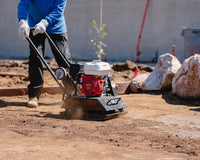A well-constructed gravel driveway can offer years of low-maintenance performance if installed correctly. It’s a practical and cost-effective solution for rural properties, vacation homes, or as a temporary access road. However, even the best gravel won’t hold up if it's laid over poorly prepared ground or without proper compaction. This comprehensive guide walks through each stage of gravel driveway installation, with a focus on the tools and techniques that ensure structural integrity and long-term stability.
Step 1: Site Planning and Marking
Begin by outlining the path of the driveway using marking paint, string lines, or stakes. This layout should follow the natural grade where possible to assist with water runoff and reduce excavation work. Consider driveway width and whether you'll need to accommodate two-way traffic or just a single lane. Most residential driveways are between 10 to 12 feet wide. Additionally, check local zoning or easement requirements before you begin, especially in areas with stormwater regulations.
Proper drainage should be part of the plan from the outset. A crowned surface, where the center is slightly higher than the edges, helps shed water efficiently. In flat or wet regions, side ditches or culvert pipes may be necessary to divert runoff.
Step 2: Excavation and Grading
Once the layout is finalized, excavate the topsoil and any organic material down to a depth of at least 6 to 12 inches. This base depth varies depending on local soil conditions and intended traffic volume. Removing loose or clay-heavy soil is essential to avoid future settling. After excavation, shape the subgrade with a gentle crown to direct water away from the centerline.
At this stage, using compacting tools becomes crucial. The Tomahawk 3 HP Vibratory Rammer is ideal for consolidating loose soil in narrow trenches or challenging terrain. A stable subgrade is the foundation for everything that comes next.
Step 3: Laying the Base Layer
The base layer should consist of coarse crushed stone (often referred to as #3 or #4 stone) with pieces ranging from 1 to 2 inches in diameter. This stone offers excellent drainage and compacts well. Spread it evenly across the entire width and length of the driveway using a skid steer or manual rakes, then compact thoroughly. For larger areas, a plate compactor like Tomahawk’s 5.5 HP Honda Plate Compactor can speed up the process and provide even results.
After compaction, this layer should be firm underfoot, with no shifting when walked on. Avoid the temptation to skip compaction—it’s what locks the stone together and prevents premature rutting.
Step 4: Adding the Middle and Surface Layers
The second layer consists of smaller aggregate (like #57 stone), which fills gaps in the base layer and creates a tighter structure. Spread it evenly, then compact it just as you did with the base.
The top layer can be made from finer gravel such as pea gravel, decomposed granite, or crushed limestone. This layer provides the finished look and final driving surface. Keep in mind that smoother materials offer better aesthetics but are more prone to displacement under tire pressure.
Each layer must be compacted separately. “Compacting each layer is not optional—it’s the most critical step for a long-lasting gravel driveway,” notes HomeQuestionsAnswered.com. Vibratory rammers are especially useful along the driveway edges where heavier plate compactors may struggle to reach.
Step 5: Finishing Touches and Maintenance Tips
To complete the installation, grade the driveway with a slight crown or camber to maintain water runoff. Installing edging such as timber, steel, or concrete can help contain the gravel and reduce spread over time. Optional landscape fabric placed under the first gravel layer can prevent weed growth and slow down soil migration.
Ongoing maintenance includes periodic regrading to fill in low spots and adding fresh gravel every few years. Ensuring the surface remains crowned and compacted helps preserve its performance, especially in areas with freeze-thaw cycles or heavy rainfall.
Installing a gravel driveway is a rewarding project that can be completed in a weekend with proper planning and the right equipment. Compacting each layer not only boosts durability but also enhances appearance by giving the surface a clean, finished look. For DIYers or contractors working in residential or rural environments, compact and reliable tools like those available from Tomahawk Power provide practical advantages without overcomplicating the job.









